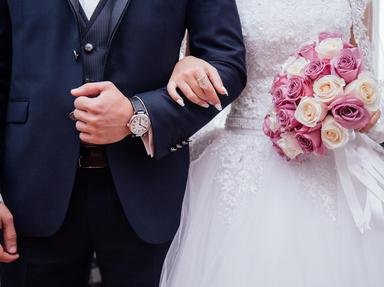Quiz Answer Key and Fun Facts
1. Men and women have been pairing up since time immemorial. The most simple form of marriage is when a couple simply decide to live together, and after a certain period of time they are considered to be married, even though they have not gone through any kind of ceremony. What is the usual name for such a marriage?
2. If a couple decides to get married, one of the first things they must do is obtain a marriage license. When marriage licenses were first issued in 14th-century England, what was the usual reason one was required?
3. Generally speaking, women are more eager to get married than men. In many western countries, a woman (or her family) was expected to bring some sort of material wealth to the marriage, presumably to make her more attractive to prospective bridegrooms. What is this wealth called?
4. Most people in the United States still opt for some form of religious ceremony to solemnize their marriage, but many people who are not religious, or who simply cannot afford an elaborate ceremony, opt to be married by a government official, such as a Justice of the Peace. What are these nonreligious marriages called?
5. Many of our marriage customs are of fairly recent origin. Take, for example, wedding dresses. Most wedding dresses in the United States are white (or some shade of off-white). But this wasn't always the case. The wedding of which historical figure started the trend for white dresses?
6. In most western countries, one is allowed to have only one spouse at a time. But some societies allow a person to be married to more than one person at the same time. What is this practice called?
7. Lots of little girls dream about falling in love and marrying a handsome prince. It might surprise them to learn that even if she did win the heart of a prince and marry him, in many European countries she would not become a princess, and, furthermore, any children she and the prince might have would be barred from inheriting his throne. What is the term for a marriage between persons of unequal rank, which prevents a nobleman from passing on his titles to his wife and children?
8. Many modern wedding practices date from ancient fertility rights. In the United States (and many other countries), what is traditionally thrown at a newly married couple to ensure that their union will be fruitful?
9. What is an American expression for a marriage that is hastily arranged because the prospective bride is pregnant?
10. In modern society, same-sex marriages are becoming more common, and are recognized as legal in many countries, including the U.S. At one time, however, homosexuality carried a profound social stigma, and was illegal in most jurisdictions. Many gays and lesbians entered into marriages of convenience with members of the opposite sex in order to disguise their sexual orientation. What color was used to describe such marriages?
Source: Author
daver852
This quiz was reviewed by FunTrivia editor
trident before going online.
Any errors found in FunTrivia content are routinely corrected through our feedback system.

